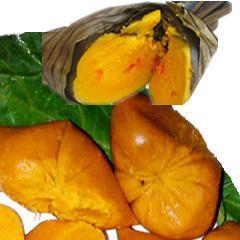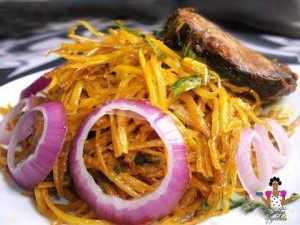
One article carried in Aro News indicated that:-
“Amuvi Village is one of the nineteen villages of Arochukwu in the Arochukwu local government area of Abia state. It is a village which is unique and refreshingly different from most of the other villages of Arochukwu. Amuvi is perhaps one of the best planned villages in Nigeria, in fact the whole of Africa. Thanks to that indefatigable gentleman, Sir Alex Onyeador of blessed memory, the Village is properly mapped and laid out. The layout is only comparable to that of a good town planning authority. The situation is such that every home in Amuvi has a drive way aborting into one of the network of roads.” – (Author: Mazi Barrister Ndionyemma Nwankwo)
This quotation relates to only the few physical environment that were very well observed in Amuvi. Scientific theses in a human society actualizes physical environment as a visible manifestation of the beliefs, attitudes, and behavior of the inhabitants. These three key variables namely, beliefs, attitudes, and behavior are aggregates of the historical past of the people. They are embedded in the culture and custom of the people which being dynamic, inculcate their past, their joys and sorrows, triumphs and failures through a trail of challenges, prospects and constraints. The psyche of a people, their world view, are therefore a reflection of their past. By methodically analyzing their present, one can with some acceptable degree of certitude have a satisfying peep into their history. This concept is here adopted in this brief history of our beloved Amuvi-Uda.
Amuvi’s early history, is definitely within the larger Aro Confederacy, which I adequately presented in Pages xii to xiv; 1 to 48 and 243 to 250 of the book “Perspectives in Aro History and Civilization — The Splendor of a Great Past” Vol 1. It is a pre-requisite reading for a meaningful appreciation of this article. This is because, a lot of matters have been taken as known and bypassed completely or skimmed through in this report, on the understanding that they have been extensively studied and dealt with in that book. In the book, Aro history was specifically explored alongside other contemporary and related developments within involved history of relating external nations – Portugal, France, United States and England.
For a start, let us recall that there was a migration of Igbo elements southwards from their main heartland east of our current Nigeria’s south to earn more living and farming zones with their increase in population.
Two Igbo dynasties led by Nnachi Ipia and Agwu Inobia north of the Ibibio and Uneghe territory, needed a more feasible movement to the sea shores for marketing links with the Portugal merchants. That involved fees and payments to the Ibibio dynasty of Obong Okon Ita whose primary base was then in Obot Okon Ita now our current Obinkita. To create piece, and feasibly be allowed to travel freely through for commercial business, Nnachi Ipia, a professional traditional medicine-man created an Igbo marriage from the clan of Agwu Inobia to Akpan Okon. This though did not provide their sought for business solutions. With the death of Akpan Okon these two Igbo family heads exploited the prospect of enthroning on the Ibibio dynasty the male issue, Ulu Okon, otherwise known as Kakapko, from the marriage of the Igbo maiden to Okon Ita in contrast to his due senior brother Akpan Okon. This resulted in a civil strife among the Ibibio tribe in which the Igbo community got involved in support of their choice Ulu Okon.Thus, began the 1534 Igbo-Ibibio War in which the Igbo units got the Ekoi, nicknamed Akpa led by Osim, a tribe of big game hunter-community residing on the eastern banks of the Cross River north of the present Akamkpa, also needing a less tariffs and taxes laden route to the coastal markets for their ivory, hides and skin.
Osim, the leader of the Akpa tribesmen lost his life in the course of the Ibibio war and his sibiling AkumaNnubi stepped into his shoes. The three confederating dynasties had administrative headquarters in Utughugwu, Ugwuakuma and Amanagwu respectively. Obot Okon Ita the historic base of the evicted Ibibio clan (which today is known by its corrupt Igbo rendition of Obinkita), was retained by Ulu Okon as head of the collaborating remnant Ibibio elements sympathetic to and These four were the first in the series of City States of Confederate Aro.
Because of their loss of land and particularly their oracle IbitItam/Ibritam (giant drum) reported by Prof. Monday B. Abasiattai as developed by the Idiong secret society about 300 AD, the evicted Ibibio elements began invasions for a reversal to the status quo in sporadic skirmishes. Aro on taking over this giant drum renamed it Ibit Ukpabi (drum of Ukpabi = drum of God), which earned more names, Ibiniukpabi and Long Juju, As a result, the young Aro state had the persistent need to maintain and if necessary, expand its territorial integrity. To this effect, the eminent groups took defense locations by border posts. As a result the growth of residency and homesteads at these border posts arose as the young vigilante guards settled down, married and acquired households and led to the creation of autonomous City State statuses. These as would be found with related trends in my indicated study report, were in a close sequence of Amasu, Ujari, Amukwa, Atani, Ugbo, Amoba, Ugwuavor, Amukwa, Amamgba, Amankwu.
The growth of population pressures and increased security to Aro Confederacy, created a demand and opportunity for Oti Oke and Umahi Nlenanyato move further north of Amamgba, beyond Asaga and the Nwanne flood plain to the promontory which is today Ogo-Amuvi.
At this age, the three OKE NNACHI, IBOM ISII AND EZE AGWU, had been with the following Otusi governances with some Aro City States:-
OKE NNACHI:-
Otusi OkeNnachi – Oror, Utughugwu, Amankwu and Part of Obinkita;
Otusi Amaja – Isinkpu, Amangwu, Part of Asaga and Part of Atani;
IBOM ISII:-
Otusi Nna Akuma (UtiziUmnnaImuo)–Agbagwu, Part of Ibom;
Otusi Amata (Otusi OkoninaUkoro) – Amasu, Part of Ibom;
Otusi Ivi Njoku – Ajari, Amukwa, Part of Atani;
EZE AGWU:-
Otusi Eze Agwu – Amanagwu, Obinkita, Part of Atani;
Otusi Umunna Okwara Agwu – Ugbo, Ugwuavor, Amoba;
The fast growth Aro City States is here briefed to lay in the track to founding of the last in the series – Amuvi Uda. Mazi Akpakoro lgwe-Abah the family head at Amamgba was later joined by Bianko Nnaezuma and Eze Jaka and three children of Mazi Oke-Nnachi’s many wives, namely, Oti Oke, Ezuma Oke and Abiara Oke. Ngwu and Mkpu the children of Eze Jaka, moved off Amamgba to create the present day Amangwu and Isimkpu respectively.
With the growth of the family of the three sons of Oke Nnachi , namely Oti Oke and Ezuma Oke of the same mother while Abiara Oke was of another of their father’s several wives, they spread from Amamgba to cover the present Asaga. The principal Aro trade route to the Igbo heartland was through Asaga City State, a prominence it was to later loose with the founding of Amuvi. The initial habitation of Asaga was therefore attributable to these three brothers and explains the land tenure and ownership structure among the Umuoti kindred in Asaga and Amuvi. As more families moved to new Asaga habiliments, the remnants of the initial and expanded inhabitants of Amamgba now consisted principally of the homesteads of Ezuma Oke and Umahi Nlenanya.
The opening up of new settlements of Amuvi was the sole prerogative of those wealthy ones who had earned the status of Mazi namely, Oti Oke and Umahi Nlenanya who were both wealthy and noble merchants of the lineage of Oke Nnachi. It is therefore at this stage, which is about year 1630 that Oti Oke and Umahi Nlenanya planned and executed their permanent and independent residency to migrate to a more spacious land track north of Amamgba, beyond Asaga and the Nwanne flood plain to the promontory which was to be later known as Ogo-Amuvi.
Subsequent wealth and population increases led to the development of more compounds (ezi) from the initial Nde Ezuma Oke and Nde Umahi Nlenanya both separately also known as Eziukwu and Ugwogo. These two names were not derived from the name of any individual. The one related to the senior member of the founding sibilings – Ezi Ukwu (the large compound), while the other related to the topography of the initial habitation – Ugwu Ogo (the hilltop city state). Ugwogo for ease of administration arising from increasing homesteads, was split in time into five compounds, namely. Nde Umahi Nlenanya, Nde Okoro Mgbo, Nde Obia, Nde Onyike, and Nde Igweoti.
This group earned the name Amuvi even before the City state status was created in Aro state. They protested contributing fighting men and material for the territorial defense of Aro against occasional Ibibio invasions that persisted after the war. The community propounded the theory that each village should defend its own borders with its own men and material. They consequently held the Makor community in perpetual check far beyond the Iyi-Ivara flood plain. The community thence acquired the name Amauvi meaning a rebel village. It is also reported that they relied more on a unique battle strategy to soly instill fear on their Ibibio neighbors. They sallied out into the highlands of Makor and Obot Mme, shot arrows into the loose grounds, tree trunks and branches, and withdrew un-noticed. When the lbibio later saw these volleys of arrows, they reasoned that any enemy who shot such much arrows without his enemy being in sight was capable of the greatest savagery imaginable on his enemy in any combat. Amuvi has since been at peace with these neighbors and only lost that vast track of land through the stroke of pen of the Nasir Boundary Adjustment Commission in post 1967-70 Nigeria-Biafra war.”
When the community demanded autonomous City State status, the principles of Aro democratic principles necessitated the creation of one more compound. It was the basic principle of Aro governance, that for a majority opinion to be established the number of voters has to be odd, otherwise there could arise such a spilt as not to afford any side a winning vote. Ezinta was thereupon created from Eziukwu around the personnality of Esomonu Okoronkwo Ota, to make up the present Ezi-Asaa Amuvi.
On its creation, the new OKE NNACHI’s OTUSI BIANKO (Otusi Nna Ezuma) was created for Asaga and Amuvi only to make up the total nine Otusi resident in Aro. Amuvi-Uda:
This new City State took over from its sister city state Asaga, the special status of being the entry and exit point to and from the Igbo heartland. It earned the niche name of Obichiri Uzo An’utu” (customs’ post) as well as “Amuvi-Uda.” Why Uda? Most towns and villages in Igboland derive their names from either animals or inanimate objects. Uda is a plant and a unique one for that matter. H. G. Baker in his book “Plants and Civilization”, stated that “plants are basic to civilization as sources of food for man and other animals, energy, fibre, drugs, structural materials and other products useful to man; maintaining oxygen balance, aesthetics, checking erosion, water shed protection, storm breaks, shades from the sun etc. etc. The botanical name for Uda is Xylopiaaethiopica and is known as atarabang or atta among the lbibio and Efik. The Hausa call it kimba, the Yoruba know it as erunje, while the Bini call it unien. The root botanical name Xylopia means in Greek ‘wood with a bitter taste.’ The edible part, the fruit consists of numerous carpels, about a dozen, narrow, 2-3 in. long and 0.25 in. thick, stalkless, on a thick common stalk up to 2 in. long; reddish at first, eventually blackish; containing 4-9 seeds with an aril at the base. The seed is peppery”.. Uda has known medicinal values. It has been indicated for promoting blood circulation, appetite and digestion; slowing senility; increasing flow of breast milk in nursing mothers; management of varicose veins, colds, asthma, eodema, alcoholic hangover, insomnia and dry skin among several others. It is above all, a good seasoning agent and is often combined with utazi (Gontronemalati folium), oshosho (Tetrapleuratetraptera), nchuanwu (Ocimumviridis), and uziza (Piper guineense) for greater effect. To this extent, it is a reputed foods seasoning agent providing flavors richer than either fish or meat. That is Uda for you. It is therefore not surprising that Amuvi citizens are especially noted for their catalytic initiatives, constructively salutary and altruistic influences in whatever sphere of life they may find themselves.
Amuvi introduced ‘Okpa and Nsisa’ to the Arochukwu community. The Okpa delicacy is prepared from the cow-pea stuff. When men were boys, this delicacy was wrapped with the plantain or banana leaves. In recent years, the use of water-proof as a foil makes Okpa to lose its traditional taste.

Whether with plantain leaf or water proof foil, the demand for this delicacy and its supply could not meet at ‘Equilibrium’.
The demand for Okpa over-shot the supply which was why at its shopping centre along Amuvi – Agbata Uzo road, many women joined the trade which compelled the women to take their different days of the supply of Okpa, turn by turn. One can only supply on her own day, otherwise, the woman has fouled the Okpa Union Law.
Tapioca is a bye product of cassava, which is known as Nsisa. This delicacy is a basic appetizer by any Amuvi family to her visitors before the real food is dished out.

At family meetings, burials and or traditional wine carrying, Nsisa plays a major role.
At such ceremonies, those who returned from far and near would anxiously wait for Nsisa, And if Nsisa was still far away or perhaps on its way but have not arrived, people would openly ask, ‘where is Nsisa’.
The entire Arochukwu community has been infested with these ‘Amuvi’ delicacies as though it was their traditional diet. These delicacies found their way from the Udi and Isuochi areas respectively, and have refused to return to their source/root. They have become so indispensable that the community fill guilty if they suffer a lack of these delicacies especially when their children were returning to their respected cities after a visit to the village without a parcel of either or both delicacies.